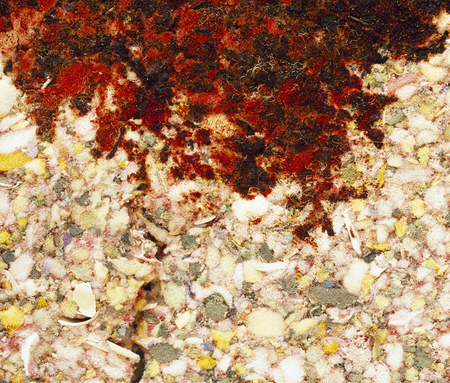At the Hour of Our Death
Sarah Sudhoff
Our worldly possessions speak to how we live, while their particular aesthetics — the whorl of this cushion, the filigree of that doily — hint at personality. In her series, At the Hour of Our Death, artist Sarah Sudhoff explores how our stuff reveals how we die, and reminds that we do die, and so do the ones we love from whose deaths we are detached. Sudhoff photographs the stains left behind from suicides, murders and other messy deaths.
Filmmakers Mark and Angela Walley produced a short documentary about Sudhoff and her work:
[Video not working because Vimeo is evil? Click here.]
Sudhoff’s intention with this work is to draw attention to the often invisible process and remnants of death. Normalized efforts to erase or conceal — or incinerate, as is the case of the fabric swatches she photographs — the evidence that death leaves behind, including the body itself immediately swept from view until the funeral, isolate us from our loss and make grief impersonal and arguably more difficult than it already is.
I say “arguably” because seeing the blood splatters of a loved one’s suicide would probably freak out and traumatize most people more than it would aid their mourning. Nevertheless, this sanitizing of death is a denial of reality and dislocates our understanding and acceptance of death. Sudhoff’s work recognizes and acknowledges the marks death leaves behind, on pillow shams and drapes but also on us.
A bit morbid, sure, but this is the Death Reference Desk. And if I may, while granting Sudhoff legitimacy in her artist statement, and at the risk of being creepy or insensitive, I am personally less interested in the death tie-in than I am in the pure aesthetics of the work.
Ignore for a moment that these images are saturated with the gore of the dead. Why? Because otherwise is too easy — too emotional, too blatantly taboo and therefore transgressive, and while Sudhoff does not seem to aim for shock, the context sends interpretation down a single, obvious, kinda gross but we-should-feel-good-about-ourselves-for-thinking-about-death-and-the-consequences-of-its-social-sublimation path.
And you know what? These photographs are really rather pretty on their own and function as effective works of art without all that weight.
 In the serendipitous way propriety and rules and stuff impose boundaries on Art, Sudhoff was unable to photograph actual crime scenes. Instead she is allowed to shoot their remnants pulled from the biohazard boxes of a death scene cleanup company. Fabric swatches are tacked to a wall, flooded with lights and photographed. While perhaps she would have done this anyway, this arrangement forces intense close-ups on the fabrics, as opposed to wider angle, let’s-see-the-whole-room, imagine-the-moment shots that would put us closer to the dead.
In the serendipitous way propriety and rules and stuff impose boundaries on Art, Sudhoff was unable to photograph actual crime scenes. Instead she is allowed to shoot their remnants pulled from the biohazard boxes of a death scene cleanup company. Fabric swatches are tacked to a wall, flooded with lights and photographed. While perhaps she would have done this anyway, this arrangement forces intense close-ups on the fabrics, as opposed to wider angle, let’s-see-the-whole-room, imagine-the-moment shots that would put us closer to the dead.
Instead, we have only a moment, and that moment is abstract and evocative. The textiles themselves are both art and commodity. Even a foam carpet pad, with its texture and color, has a weird, familiar but rarely recognized beauty.
The stains that seep can be seen as corruption or defacement — defects in these products. And yet there is balance and harmony, a rightness in the randomness. Nonetheless, even if you didn’t know it was blood, the creeping distortions signal that something is dreadfully wrong, complicating that beauty (or, ironically, enlivening and enriching a mundane pattern).
Combined with context — knowledge of what these stains don’t represent but actually are — Sudhoff’s work achieves a subtle power easy to overlook when we’re so quick to look away.
If you’re into this stuff (heh), check out Sudhoff’s other photo series linked on the left side of her website, including medical waste and sacks of unclaimed cremains.
One reply on “Sick Beauty in the Stains of Death: Sarah Sudhoff’s “At the Hour of Our Death””
This is pretty morbid, even for a licensed funeral director. This does present a unique perspective on death. In our culture the need for acceptance of the reality of death is great. It does in a strange way contributed to death acceptance.